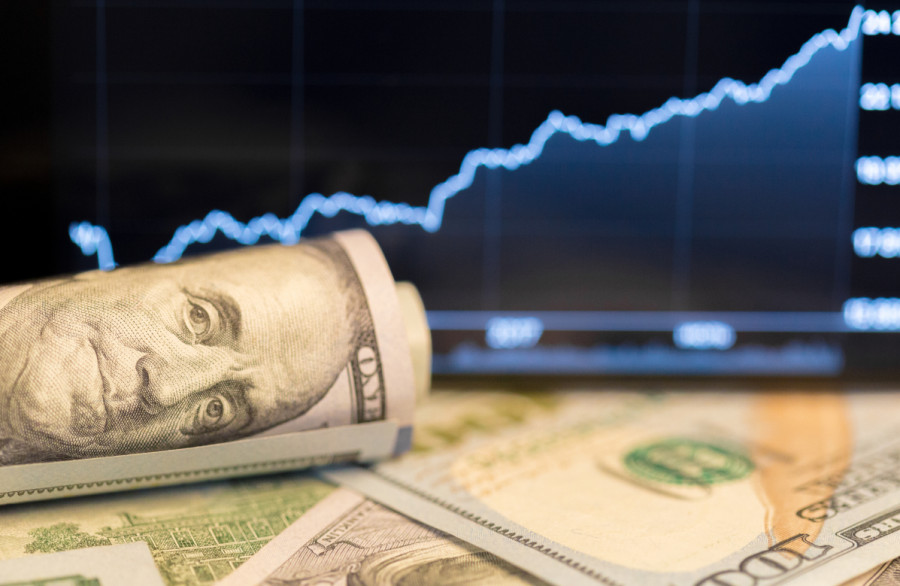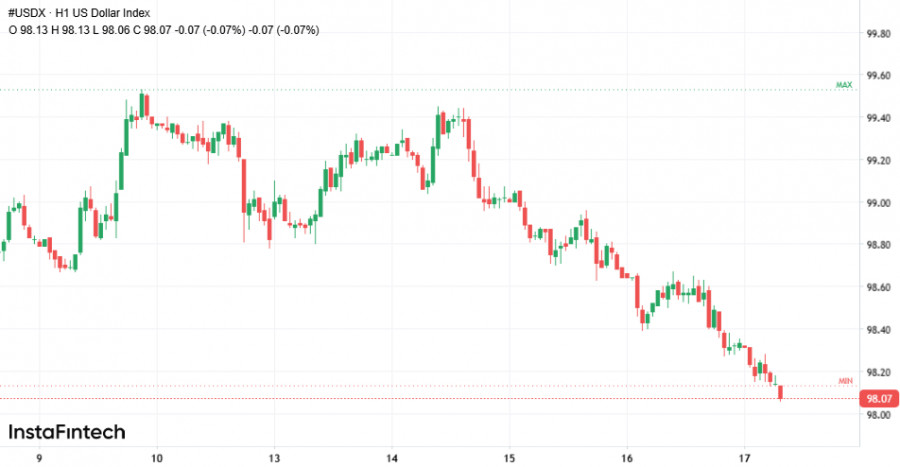The US dollar index slipped by 0.7% this past week — its worst weekly performance since June. Starting from Thursday, the greenback has been weakening for four consecutive trading days, and this isn't just a short-term correction. It's a clear sign of a growing bearish trend. So, what's driving this unexpected decline—and what lies ahead for the American currency?
Unexpected downturn: what's pushing the dollar lower
This week turned out to be a rough one for the dollar. The dollar index fell by 0.7% — the steepest weekly decline since June. The greenback has now been falling for four sessions in a row — a rare occurrence for such a liquid and typically stable market. That alone has caught the attention of traders and analysts.
Several unfavorable factors have come together to pressure the dollar.
First and foremost, dovish signals from the Federal Reserve have weighed heavily on the currency. Top Fed officials, including Chair Jerome Powell, made it clear this week that they are ready to continue cutting interest rates if needed to support the softening labor market.
Fed Governor Christopher Waller stated bluntly that the Fed is prepared to keep trimming rates in gradual steps of 25 basis points to stabilize employment.
Adding to this sentiment, analysts at Morgan Stanley now expect the next rate cut could come as early as the Fed's October meeting.
As a result, markets are pricing in an even more aggressive easing trajectory: by year-end, traders now expect the Fed to cut rates by 53 basis points—up from 46 basis points just one day earlier.
The second major factor weighing on the dollar is the decline in US Treasury yields. The yield on 2-year Treasuries fell to a six-week low, making dollar-denominated assets less attractive to yield-seeking investors.
The third issue is the ongoing political crisis in Washington: the US government has now entered its third week of a partial shutdown, with no resolution in sight.
The lack of fresh economic data, due to the shutdown, has only heightened market uncertainty and fueled speculation about further dovish moves by the Fed.
Sentiment in the FX market has turned increasingly bearish in the short term. Although the dollar still has strong fundamental backing that could lead to a rebound later this year, in the near term, most traders are betting on continued downside.
And finally, troubling signs from the US banking sector have added to the pressure. Emerging issues with lending and balance sheet risks have further dampened confidence in the dollar, triggering a wave of significant sell-offs.
In summary, what started as a moderate pullback has now become a broader bearish shift driven by dovish Fed talk, falling yields, political deadlock, weak data flow, and rising financial sector concerns. Whether the dollar can recover will depend on how these risks play out in the coming weeks.
The banking factor: fraud and panic on Wall Street
So, the Fed's dovish rhetoric has coincided with turmoil in the financial markets, sparked by revelations of fraud and losses among regional US banks. While the bond market has remained relatively calm, the banking sector is clearly not in an optimistic mood.
Two regional banks have taken center stage: Zions Bancorp and Western Alliance Bancorp. Both institutions reported falling victim to fraudulent lending schemes. Zions' subsidiary, California Bank & Trust, issued $60 million in loans to borrowers now suspected of being involved in fraud—namely, investment funds managed by Andrew Stupin and Gerald Marcil.
Legal representation for the individuals in question claims that the accusations are "unfounded" and promises that, once all evidence is presented, the case will end in full exoneration. But markets run on emotions—while investigations are just beginning, investor reaction has been swift.
The combined market capitalization of the 74 largest US banks shrank by more than $100 billion in a single day—a dramatic correction even by banking scandal standards.
Ironically, the actual losses involved in these fraud cases are relatively minor—just tens of millions of dollars—especially when compared to recent high-profile collapses, such as Tricolor Holdings' auto loan meltdown or the bankruptcy of First Brands Group, which owed Wall Street's top creditors more than $10 billion.
Still, even modest losses can trigger tremors when they come from within the banking sector. Market participants are increasingly unnerved not by the size of the losses, but by the frequency. Year after year, the industry experiences what were once deemed "isolated" incidents—but now the pattern suggests something more systemic. Growing fears point to a contagion risk that could spread through the financial system.
The shift in sentiment had an immediate impact on stock prices. Zions shares plummeted 13%, marking their steepest one-day drop in six months. Western Alliance saw its stock plunge by 11% after disclosing losses tied to the same borrowers.
As JPMorgan Chase analysts succinctly put it: "In this industry, especially for new investors, people tend to sell first and ask questions later." Experts are scrambling for answers as to why these write-downs are emerging in unison—fueling deeper concerns about the sector's underlying stability.
The spike in attention to a few fraud cases hasn't just tanked share prices of individual banks—it's also reignited debates about just how vulnerable regional lenders remain, particularly just three years after the last U.S. banking crisis.
As JPMorgan CEO Jamie Dimon vividly warned: "When you see one cockroach, there may be more."
Investors should stay alert—any new developments from the sector could keep rattling the dollar, especially amid growing market anxiety and ongoing turbulence.
How should traders react? Strategy amid dollar decline
With a growing bearish trend in the dollar and heightened volatility in the banking sector, markets are demanding clear strategy and level-headed risk management from participants. Now more than ever, it's essential not to be swayed by market noise—and to base trades on rational analysis.
First and foremost, diversify your currency portfolio. Expectations of continued Fed easing and a weakening dollar present fresh opportunities elsewhere.
Currencies such as the euro, yen, and traditional "safe havens" may prove more resilient in the near term. Short-term long positions against the dollar look justified from both fundamental and technical standpoints.
Under current conditions, prioritize quick profit-taking and tight loss parameters. With markets this volatile and unpredictable, long-term dollar strategies carry significantly heightened risk. Investors are advised to explore short-dollar positions—with disciplined stop-loss levels.
But most importantly—maintain discipline, don't overreact to short-term noise, and closely monitor Fed communications and major bank earnings reports. This phase calls for cautious, targeted tactics and a sharp eye for detail. Those who stay focused can protect their capital—and seize new growth windows in an increasingly choppy market.















